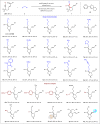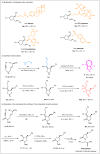Nickel-catalyzed electrophiles-controlled enantioselective reductive arylative cyclization and enantiospecific reductive alkylative cyclization of 1,6-enynes
- PMID: 38413585
- PMCID: PMC10899222
- DOI: 10.1038/s41467-024-45617-0
Nickel-catalyzed electrophiles-controlled enantioselective reductive arylative cyclization and enantiospecific reductive alkylative cyclization of 1,6-enynes
Abstract
Transition metal-catalyzed asymmetric cyclization of 1,6-enynes is a powerful tool for the construction of chiral nitrogen-containing heterocycles. Despite notable achievements, these transformations have been largely limited to the use of aryl or alkenyl metal reagents, and stereoselective or stereospecific alkylative cyclization of 1,6-enynes remains unexploited. Herein, we report Ni-catalyzed enantioselective reductive anti-arylative cyclization of 1,6-enynes with aryl iodides, providing enantioenriched six-membered carbo- and heterocycles in good yields with excellent enantioselectivities. Additionally, we have realized Ni-catalyzed enantiospecific reductive cis-alkylative cyclization of 1,6-enynes with alkyl bromides, furnishing chiral five-membered heterocycles with high regioselectivity and stereochemical fidelity. Mechanistic studies reveal that the arylative cyclization of 1,6-enynes is initiated by the oxidative addition of Ni(0) to aryl halides and the alkylative cyclization is triggered by the oxidative addition of Ni(0) to allylic acetates. The utility of this strategy is further demonstrated in the enantioselective synthesis of the antiepileptic drug Brivaracetam.
© 2024. The Author(s).
Conflict of interest statement
The authors declare no competing interests.
Figures








Similar articles
-
Ni-Catalyzed Enantioselective Reductive Cyclization/Amidation and Amination of 1,6-Enynes and 1,7-Enynes.Angew Chem Int Ed Engl. 2025 Jan 2;64(1):e202413892. doi: 10.1002/anie.202413892. Epub 2024 Oct 24. Angew Chem Int Ed Engl. 2025. PMID: 39193806
-
Nickel-catalyzed switchable arylative/endo-cyclization of 1,6-enynes.Nat Commun. 2024 Apr 4;15(1):2914. doi: 10.1038/s41467-024-47200-z. Nat Commun. 2024. PMID: 38575585 Free PMC article.
-
Nickel-Catalyzed Ligand-Controlled Selective Reductive Cyclization/Cross-Couplings.Acc Chem Res. 2023 Mar 7;56(5):515-535. doi: 10.1021/acs.accounts.2c00771. Epub 2023 Jan 23. Acc Chem Res. 2023. PMID: 36688822
-
Nickel-Catalyzed Arylative Cyclizations of Alkyne- and Allene-Tethered Electrophiles using Arylboron Reagents.Chemistry. 2022 Mar 28;28(18):e202104230. doi: 10.1002/chem.202104230. Epub 2022 Jan 27. Chemistry. 2022. PMID: 34986277 Free PMC article. Review.
-
Development of new palladium(0)-catalyzed reactions based on novel oxidative addition mode.Yakugaku Zasshi. 2008 Sep;128(9):1259-66. doi: 10.1248/yakushi.128.1259. Yakugaku Zasshi. 2008. PMID: 18758139 Review.
References
-
- Fattorusso, E. & Taglialatela-Scafati, O. Modern Alkaloids: Structure, Isolation, Synthesis and Biology (Wiley-VCH, 2008).
Grants and funding
LinkOut - more resources
Full Text Sources

